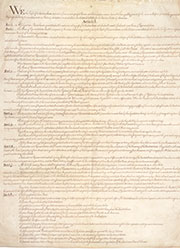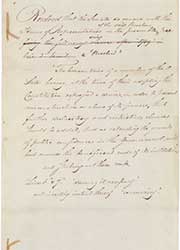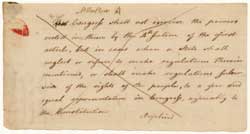
Why a Bill of Rights?
“A bill of rights is what the people are entitled to against any government on earth, general or particular, and what no government should refuse, or rest on inference.”
Thomas Jefferson to James Madison, December 20, 1787
No Need for a Bill of Rights
The omission of a bill of rights from the Constitution was deliberate, not an oversight. George Mason proposed adding a bill of rights just five days before the Constitutional Convention ended. But after a short debate, the state delegations voted down the motion, 0–10. That became a problem during the ratification process when several states insisted on protection of rights.
Voting Record of the Constitutional Convention, showing the vote on the motion to appoint a committee to prepare a bill of rights, 1787, Records of the Continental and Confederation Congresses and the Constitutional Convention
Dangerous and Unnecessary
Supporters of the Constitution, the Federalists, thought a bill of rights was unnecessary and even dangerous. The authors of The Federalist Papers, including James Madison, argued for ratification of the Constitution without a bill of rights. They thought no list of rights could be complete and that therefore it was best to make no list at all.
Almost Fatal Mistake
The omission of a bill of rights proved to be a mistake almost fatal to the Constitution. New York and several other states agreed to ratify with the promise that the First Congress would add rights to the Constitution through the amendment process. These states might have rejected the Constitution without the promise of a future bill of rights.
Ratification of the Constitution by New York, with proposed amendments, July 26, 1788, Records of the General Government
Why a Bill of Rights?
The First Congress included a preamble to the Bill of Rights to explain why the amendments were needed. Declaring that they were a response to the demand for amendments from the state ratifying conventions, the preamble states that Congress proposed them "to prevent misconstruction or abuse of its powers" and to extend "the ground of public confidence in the government."
Change to the preamble to the Bill of Rights, August 25, 1789, Records of the U.S. Senate
The Ones that Failed
These motions suggested additional amendments during debate in the Senate. They came from state ratifying conventions, as did most of the amendments proposed by James Madison in the House of Representatives. Motion C was proposed again by Congress in 1810, but wasn’t ratified. It would have denied public office to anyone who accepted a “title of nobility” from a king.
Motions A–D proposing amendments that failed in the Senate, September 7, 1789, Records of the U.S. Senate
Editing the Bill of Rights
The Senate reworked the amendment language passed by the House of Representatives. Their marked-up draft spilled the most ink on the Third and Fourth Articles, which were combined to form the First Amendment. It protects freedom of religion, speech, and press, and the right to assemble and petition.
Senate Revisions to House Proposed Amendments to the U.S. Constitution [Senate Mark Up of the Bill of Rights], September 9, 1789, Records of the U.S. Senate
225 Years Old
The Bill of Rights became the first 10 amendments to the Constitution when Virginia ratified them on December 15, 1791. Of the 14 states in the Union, Virginia was the 11th to ratify, thus providing the constitutionally required bar of three-quarters of the states needed for ratification. Since 1941, December 15 has been celebrated as Bill of Rights Day.
Virginia's ratification of the Bill of Rights, December 15, 1791, General Records of the U.S. Government
Same great content in an interactive design!




![Senate Revisions to House Proposed Amendments to the U.S. Constitution [Senate Mark Up of the Bill of Rights].](/files/amending-america/images/why-a-bill-of-rights/3535588-m.jpg)
